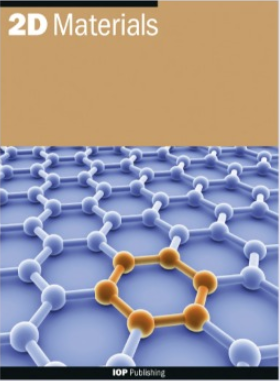Band Type Engineering Using Different Stacking Configurations of Anisotropic and Isotropic Monolayer Transition Metal Dichalcogenides
IF 4.3
3区 材料科学
Q2 MATERIALS SCIENCE, MULTIDISCIPLINARY
引用次数: 0
Abstract
Abstract This work demonstrates the band-type engineering and the detailed charge transport mechanism upon visible light illumination for various configurations of vertically stacked monolayers of MoS 2 -ReS 2 grown by a two-step chemical vapour deposition method. In order to understand the stacking order of both materials has a direct impact on the band alignment arrangements, we investigate the optical properties of both ReS 2 –MoS 2 stacking configurations using micro-photoluminescence and interestingly observed the change in the band alignment upon changing the stacking order (ReS 2 –MoS 2 and MoS 2 –ReS 2 ). The formation of the vertically stacked heterostructure is further validated by observing its morphology by HR-TEM. The MoS 2 on top of ReS 2 yielded Type II and ReS 2 on top of MoS 2 yielded type I band alignment. The fabricated photodetector exhibits responsivities of 152 A W −1 for pristine ReS 2 , 72 A W −1 for MoS 2 on top, and 400 A W −1 for ReS 2 on top respectively for visible light illumination of 554 nm suggesting that the stacking configuration of the monolayer TMDs play a vital role in the performance of the optoelectronic properties. The detailed study of such configurations of vertically stacked 2D heterostructure is essential to better understand the optimal configuration for the development of highly responsive photodetectors.各向异性和各向同性单层过渡金属二硫化物不同堆叠构型的带型工程
摘要:本文研究了两步化学气相沉积法生长的MoS 2 - re2垂直堆叠单层在可见光照射下的带型工程和详细的电荷输运机制。为了了解两种材料的堆叠顺序对能带排列的直接影响,我们利用微光致发光技术研究了两种材料的堆叠结构的光学性质,并观察了堆叠顺序改变后的能带排列变化(res2 -MoS 2和MoS 2 - res2)。通过透射电镜观察其形貌,进一步证实了垂直堆叠异质结构的形成。在res2之上的MoS 2产生II型,而res2之上的MoS 2产生I型波段对准。制备的光电探测器在554 nm的可见光照射下,对原始ReS 2的响应率为152 A W−1,对顶部MoS 2的响应率为72 A W−1,对顶部ReS 2的响应率为400 A W−1,这表明单层tmd的堆叠结构对光电性能起着至关重要的作用。对这种垂直堆叠的二维异质结构的详细研究对于更好地理解高响应光电探测器的最佳配置是必不可少的。
本文章由计算机程序翻译,如有差异,请以英文原文为准。
求助全文
约1分钟内获得全文
求助全文
来源期刊

2D Materials
MATERIALS SCIENCE, MULTIDISCIPLINARY-
CiteScore
10.70
自引率
5.50%
发文量
138
审稿时长
1.5 months
期刊介绍:
2D Materials is a multidisciplinary, electronic-only journal devoted to publishing fundamental and applied research of the highest quality and impact covering all aspects of graphene and related two-dimensional materials.
 求助内容:
求助内容: 应助结果提醒方式:
应助结果提醒方式:


